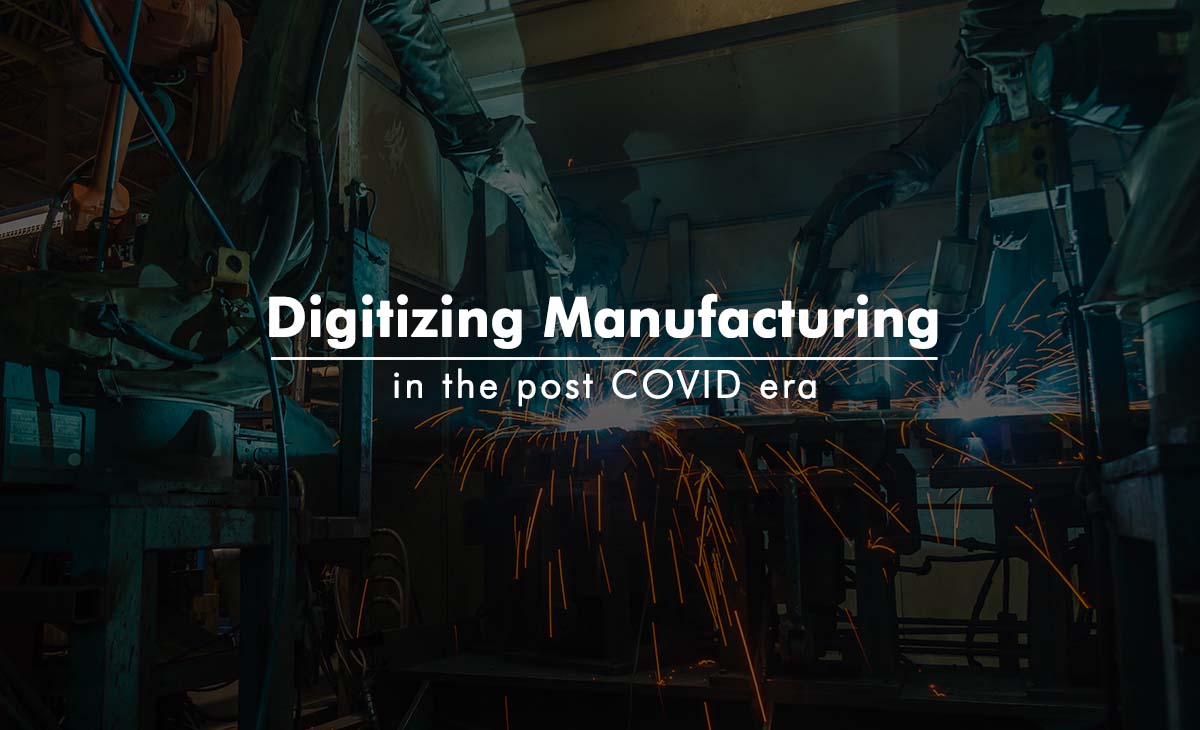
Digitizing Manufacturing In The Post COVID Era
“Digitizing manufacturing industry in the post COVID era is bridging the gap between digital and non-digital by leveraging on technology and operations over the entire value chain.”
Digitization of business practices has become the new normal in the COVID and post COVID era.
While almost every industry is getting digitized, with the digital transformation prevailing; a few businesses are still vulnerable to digitizing their business practices.
Manufacturing, unlike other industries, is a more human labor-centric industry; where manual processes, huge industrial investments, and heavy machinery capital incurs a massive amount of costs.
The manufacturing industry deals with complex business operations across its business units.
Digitizing the business practices of manufacturing processes such as procuring, Manufacturing, supplying, and delivering the goods and services resulting in a profound operational cycle over the entire value chain of Manufacturing.
However, the raw material volatility along the supply chain operations remains one of the significant issues in the manufacturing industry.
Hence, digitizing the complex business practices result in an efficient manufacturing processes ecosystem that yields overall profitability across the entire manufacturing process.
Digitization Shortcomings in Manufacturing Sector:
Unlike other industries, digitization in the manufacturing sector is quite different.
Since it is a machine and workforce-intensive industry, digitization of business practices offers a different scenario compared to other sectors.
The manufacturing business needs digitization, but the overall budgetary allocation and complex business units also need transformation.
According to recent research, 41% of respondents reported a steep decline in demand; whereas 30% of respondents reported worker unavailability as one of the significant issues in digitizing manufacturing processes.
Digital acceleration in the manufacturing business practices involves the operational activities and the streamlining of the workforce across the operations in the entire manufacturing value chain.
Furthermore, the below-mentioned common shortcomings in the manufacturing sector result in delayed results.
Data Connectivity:
Digital tools leverage the power of data to derive insights and apply digital tools in business operations.
Data connectivity plays a significant role in integrating the various business processes under one system, enabling the entire digital ecosystem.
However, the lack of data connectivity in the manufacturing industries has been a significant shortcoming in implementing a digitized business environment.
Human-Machine Interaction:
Manufacturing industries rely more on machine-human interaction to get the work done.
Since it is workforce intensive industry, it also depends heavily on workforce interaction with the heavy machines to perform the operations.
The adoption of digital practices such as logistics automation, foundational information technology, operations technology needs continuous human-machine interaction to enable critical capabilities, such as manufacturing-execution systems.
Deferred adoption of digital tools that require higher capital expenditure and a long-term payback period remains one of the shortcomings in digitizing businesses.
Analytics and Intelligence:
Emerging technologies rely on analytics and intelligence tools to achieve operational efficiency across the business units.
Most of the manufacturing processes use old traditional manual practices that often result in the same repetitive results that make business leaders make decisions that remain inaccurate with the rising innovative business practices.
Innovating the Existing Business Practices – Digitizing the Manufacturing Processes:
Innovative business practices require creative solutions, hence implying digital business practices need robust engagement from the stakeholders across its entire value chain.
Furthermore, digital technologies help mitigate the effects by boosting employee safety, operational efficiency, and product quality.
Employee Safety and Operational Continuity:
Digital emerging technologies play a vital role in achieving employee safety and operational continuity.
With digitized business practices, the exposure of employees to extremely harsh working conditions gets minimized.
Right from monitoring the details of gas pipelines, their leakages, and volume of the inventory in the areas, not humanly possible to identify the required maintenance; the digital tools take care of everything that results in a digitized business ecosystem.
Hence, ensuring employee safety along with business continuity.
Productivity and Performance Management:
The traditional manual processes, especially data recording, remain prone to inaccuracies and errors, exacerbated during crises.
Digital tools and solutions allow manufacturers to automate data by collecting it through sensors addition or by tapping into machines’ programmable logic controllers (PLCs) to display it on live dashboards.
These steps enable improved productivity of the business processes in the entire value chain of Manufacturing.
Asset Utilization and Efficiency:
Emerging technological solutions such as augmented-reality glasses enhance remote assistance in the maintenance of operational activities.
For instance, when operators need off-site assistance due to limitations on travel; such practices increase machine availability by reducing maintenance downtime.
Improved Asset Quality:
Improving the operational capabilities result in an improved business environment.
Instead, implementing digital tools to execute business processes will fetch improved business results.
For instance, machine-vision algorithms conduct an automatic quality inspection and quality control using predictive algorithms.
Increased use of bar code scanning and RFID applications in warehouse management activities has improved operational activities in the manufacturing processes.
Conclusion:
Digital transformation is the new normal. It has its benefits.
Just like the digital tools result in streamlining the business processes across the value chain; it also maximizes profits through digitized business practices.
Effective digital tools, collaboration, stakeholder engagement, and continuous efforts to achieve operational efficiency result in maintaining productivity across the overall value chain of manufacturing businesses.





